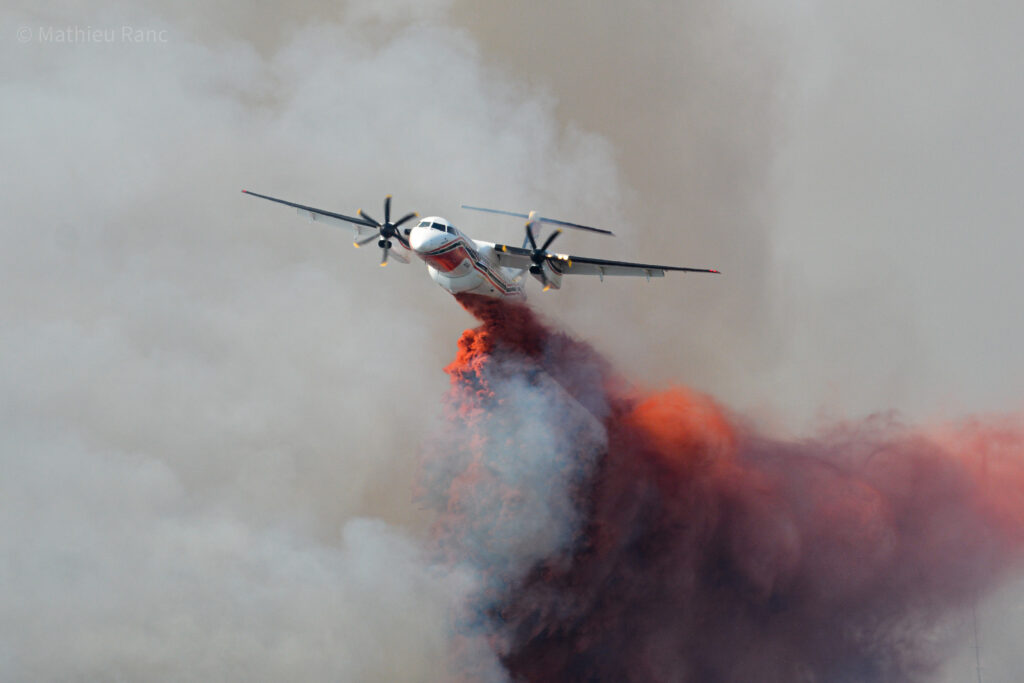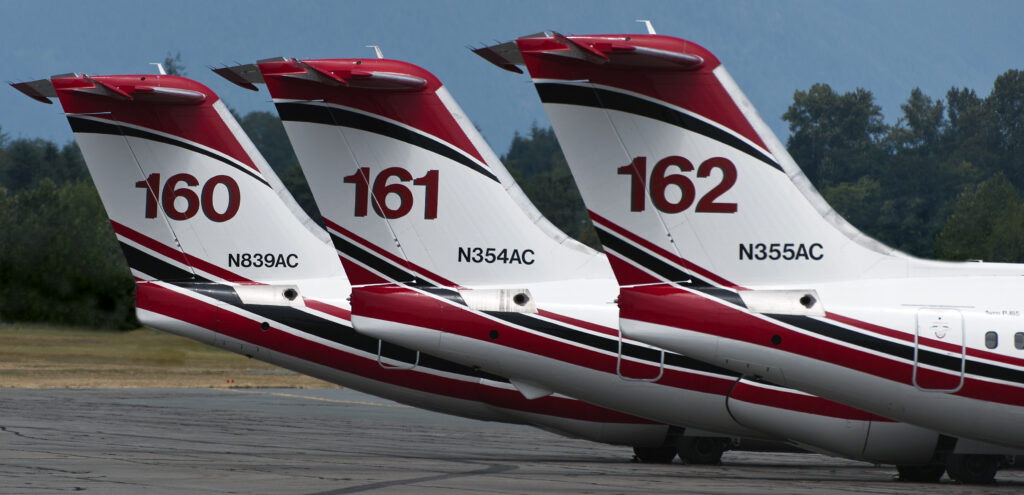While only a small percentage of wildfires grow into complex infernos, it is these select few that cause the most damage. Wildfires in the US burned over seven million acres in 2021, and megafires are becoming more prevalent, with seasons extending and requests for air tankers reaching into the winter months. With increased wildfire behavior comes greater demand for additional support. For over 50 years, Aero-Flite has continually grown to meet these needs, responding to an ever-increasing call for more tools to fight wildfires.
Aero-Flite’s methodical approach to diversifying its fleet is designed to support government agencies and firefighters on the ground, offering many aerial options intended to provide the best resources for each mission. Factors such
as heat, humidity, wind, fuel type and location play a crucial role in calculating an effective aerial response. Aero-Flite continues to evolve, growing its fleet to fill gaps, offering a range of capabilities that allow agencies to respond to a wide range of wildfire behaviors.
The company operates two main fixed-wing air tanker types, amphibious and land-based. Both are designed to work together as a team, with air tankers laying retardant lines to contain the flames and slow the spread, while super scoopers douse the blaze, allowing firefighters more chances to put out the flames on the ground. Aero-Flite provides both types to agencies, and, by this summer, will offer both Type 1 and Type 2 air tankers, capable of operating out of urban and remote tanker bases with shorter runways. This will allow the company to offer rapid initial attack opportunities by being positioned closer to where fires start.
 A History of Support
A History of Support
The company first began operations in 1963 based out of Cody, Wyoming, and later Kingman, Arizona, operating radial engine DC4 air tankers and CL-215 water bombers. In 2012 Conair purchased Aero-Flite and retired the legacy fleet, replaced by the Next Generation Type 1 RJ85 air tanker, outfitted with an external 3,000 US gallon / 11,355-liter tank designed to drop retardant or water. Also replaced were the CL-215s, replaced with the newer model CL-415.
In 2015, Aero-Flite moved from Arizona to Washington state, making its new home at Spokane International Airport, bringing 40 employees, three RJ85 air tankers, and one amphibious CL-415. Soon after establishing themselves in the Pacific Northwest, the organization grew to a fleet of seven RJ85s and four CL-415s, plus a Pilatus PC-12 dedicated to moving crew and parts, increasing its team of mechanics, pilots and support staff, cementing themselves as one of the largest privately-owned, fixed-wing aerial firefighting organizations in the US with a team of nearly 170 skilled professionals.
Success Starts with Safe Aircraft
During the firefighting offseason, typically November through March, crews perform maintenance on the fleet, preparing the tankers for deployment the following spring to the lower 48 states. Before deployment, all aircraft undergo enhanced inspections and maintenance to look for and address any wear and tear that inevitably results from aerial firefighting maneuvers. A thorough evaluation of each aircraft, with associated repairs, can take several weeks depending on the size and complexity of the aircraft type.
Supply chain agility and efficiency are the backbones of a strong aviation program as without the parts, aircraft are left grounded. Proactively predicting when aircraft parts will reach their lifespan while anticipating unexpected failures is a complicated dance that weaves together predictive analysis with years of experience. Purchasing and Stores groups work together with Maintenance to have on hand thousands of parts for the wide variety of aircraft types in the fleet, fostering strong relationships with vendors and Original Equipment Manufacturers (OEMs) around the world to secure necessary components when needed.

Incorporating Innovation with Impact
Aero-Flite continuously looks to use technology to improve outcomes, outfitting aircraft with tools that make executing missions more accurate, effective and safer, This includes installing Infrared Red (IR) cameras on the CL-415 fleet and equipping every aircraft with a second FM radio to facilitate better communications with ground firefighters and satellite voice and data communications systems, providing exact aircraft location, flight operation details, drop information and immediate voice contact with the crew.
Last year the Aero-Flite CL-415 group was upgraded with a second Angle of Attack gauge, enhancing the crew’s ability to manage the proper energy state on the aircraft avoiding unsafe conditions. In recent years the company’s CL-415 deployments to the American southwest have dramatically increased due to changing wildfire conditions and demand. Due to this change in operations, the CL-415 fleet operates in much hotter conditions, with cockpit temperatures reaching more than 113F. Lowering the cockpit temperature was critical in managing the fatigue of the aircrew. Hence, Aero-Flite undertook several heat management initiatives, including outfitting the aircrew with aviation-grade cooling vests and repainting the nose from black to white, resulting in a 42F cockpit temperature reduction.
Introducing The Dash 8-400AT to the USA
Looking ahead, Aero-Flite’s next step is introducing the new Dash 8-400AT air tanker into the US, providing a Type 2 size air tanker that offers the punch of a Type 1 while filling a needed and growing niche by giving rural communities access to a large air tanker, positioned from smaller tanker bases that can operate on airports with 5,000’ runways, providing more strategic response and reload options.
The Dash 8-400AT, or the ‘Q’ as its nicknamed, features an external tank, like the RJ85, ensuring the integrity of the airframe is protected while keeping the cabin pressurized and cockpit climate-controlled for pilot safety. The Q provides the speed of jet engine air tankers when flying short distances to wildfires and holds three ‘Time to Climb’ turboprop records. This fast response means a quick turnaround from base to fire and return, speeding up line building.The aircraft’s tank capacity allows for a 2,642 US gallon / 10,000-liter payload while emitting 30% fewer emissions and burning less fuel than air tankers of similar size, translating into both a clean environment and lower cost of operation.
The tanker has been operating in the multi-role version in France for 15 years, providing both air tanker and emergency response services, including medevac, passenger and cargo support. The air tanker version is currently operating its second season in Australia, with a long-term commitment to keep the aircraft on the continent for four years, in addition, entering its second season in Canada and Alaska, operating through Conair in Canada.

Certifying a New Airtanker
The Dash 8-400AT is currently undergoing the final phases of its certification process after finishing its grid test in California in December. COVID had, like many things, forced a pause on testing for nearly two years, with the air tanker being permitted to operate under an interim certificate. Aero-Flite has been training flight crews and aircraft mechanics on the Q and its systems for months, creating a detailed maintenance and regulatory program required by the FAA to certify the air tanker as safe for use. Also in the last stages of development is an entire logistics support program for the air tanker when it repositions to bases around the country during fire season, including trucks, trailers, parts, and tools. And there are preliminary plans in the future to build a new hangar as the fleet grows.
Available When the Call Comes
The Q is a game-changer for Aero-Flite and the aerial firefighting industry. While not the biggest, it is the most versatile air tanker capable of supporting the widest variety of wildfire types, working in partnership with large and small air tankers and amphibious fleets. The Q will be operating for years to come, fully supported by an active Original Equipment Manufacturer (OEM), ready to replace legacy fleets around the country as they age out into retirement.


